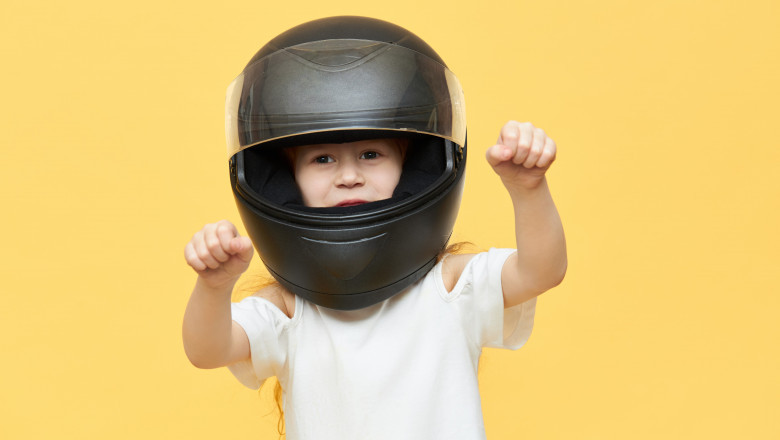views
There are lots of worries about the safety of their kids, who spend a lot of time playing, cycling, or skating with their scooters. Safety helmets have to be selected wisely in such situations. Nowadays, one popular form of kids helmet is a full-face helmet. As kids love activity, the use of this full-face helmet ensures an added amount of protection to their face area. But what is a full-face helmet, and how is it so imperative for kids to wear? It's time for a closer glance.
What's a full-face kids helmet?
A full-face helmet for kids is basically a helmet that covers the entire head, including the chin and face. In most helmets, only the top of the head is protected, but with full-face helmets, extra protection is given to the chin, jaw, and face. These are made from tough materials, such as fiberglass, carbon fiber, or polycarbonate, designed to absorb shocks in case one falls or has an accident.
Full-face helmets usually incorporate soft padding internally that creates comfort during rides. The outside shell is always designed to hold impacts that thus make them effective to prevent injury-causing factors. They are designed with a visor or a face shield in them. That protects the eyes from the attack of dust, debris, and wind.
What is the purpose of using helmets for children?
Children are naturally curious and adventurous, and they love to explore the world around them. Whether it's biking down a hill, skateboarding, or riding a scooter, these activities come with risks. Accidents can happen, and when they do, having the right helmet can make a big difference in preventing serious injuries.
Here are a few reasons why kids need full-face helmets:
1. More Protection for the Face and Jaw
A regular helmet only guards the top head, but falls often drag the face and chin. Therefore, a helmet that covers more parts of the head, the face, and the chin is a full-face helmet. Upon falling, these parts can protect one from the fracture, cut, and all other injuries as the helmet breaks the impact force on the head.
2. Wind and debris protection
When riding fast on a bike or skateboard, wind can be uncomfortable, and debris can fly into the eyes. A full-face helmet comes with a face shield that protects the child's face from strong winds, dust, and small flying objects, keeping their vision clear and reducing the chance of injury.
3. Safer for High-Speed Activities
Kids who enjoy activities like biking, skateboarding, or rollerblading are often moving at high speeds. At these speeds, falls can be much more dangerous, and a regular helmet might not offer enough protection. Full-face helmets are designed for high-impact sports, providing better coverage and safety in case of a fall.
4. Prevents Neck and Spinal Injuries
In addition to protecting the face and jaw, full-face helmets also provide better stability for the neck. The chin guard helps in distributing the impact force more evenly, which reduces the risk of neck injuries. This extra support is especially important during activities where the child might lose control and fall headfirst.
When Should Your Child Wear a Full-Face Helmet?
A full-face helmet provides more protection, but it is not necessary for every activity. There are certain scenarios in which its use is strongly recommended.
1. For Biking and Skateboarding
If your child enjoys biking or skateboarding, a full-face helmet is a must if they are riding on rough terrains, down steep hills, or performing stunts. It is risky; therefore, in case of falls or accidents, full-face helmets reduce the serious injuries.
2. When Riding a Scooter or Motorbike
Children who ride scooters or motorbikes should always wear a full-face helmet. These vehicles reach higher speeds, and a fall can lead to severe injuries. A full-face helmet is specifically designed to offer the protection needed in these high-speed activities.
3. During Extreme Sports
If your child engages in extreme sports such as BMX biking, motocross, or dirt biking, they will need a full-face helmet. These sports often involve jumps, tricks, and stunts that may cause falls with much impact. Full-face helmets would be the only thing between them and head-to-toe injuries. Choosing the Right Full-Face Helmet for Your Child
When shopping for a full-face helmet for your child, it’s essential to choose one that fits properly and provides maximum protection. Here are a few tips:
Size Matters: Make sure to measure your child’s head size accurately to get the correct helmet size. A helmet that is too loose or too tight won’t provide adequate protection.
Comfort: Helmets should be padded on the inside so your child is comfortable wearing them, especially for a long period.
Ventilation: Choose a helmet that ventilates properly so that your child feels cool and fresh while performing.
Quality: Helmets must come from good brands known for their safety. Low-cost helmets will not give the same level of protection.
A full-face kid's helmet makes a smart investment because it offers stronger protection than your average helmets would. It offers protection to cover the face, jaw, and neck, ensuring that kids engage in high-speed activities or extreme sports without fear or worry. Ensuring your little one has great fun outdoors does not have to be at someone else's peril.
For the best helmets for kids, look no further than StreetJam. They have a wide range of high-quality helmets designed to keep your child safe during adventures. Visit their website today and find the perfect helmet for your child!






















Comments
0 comment